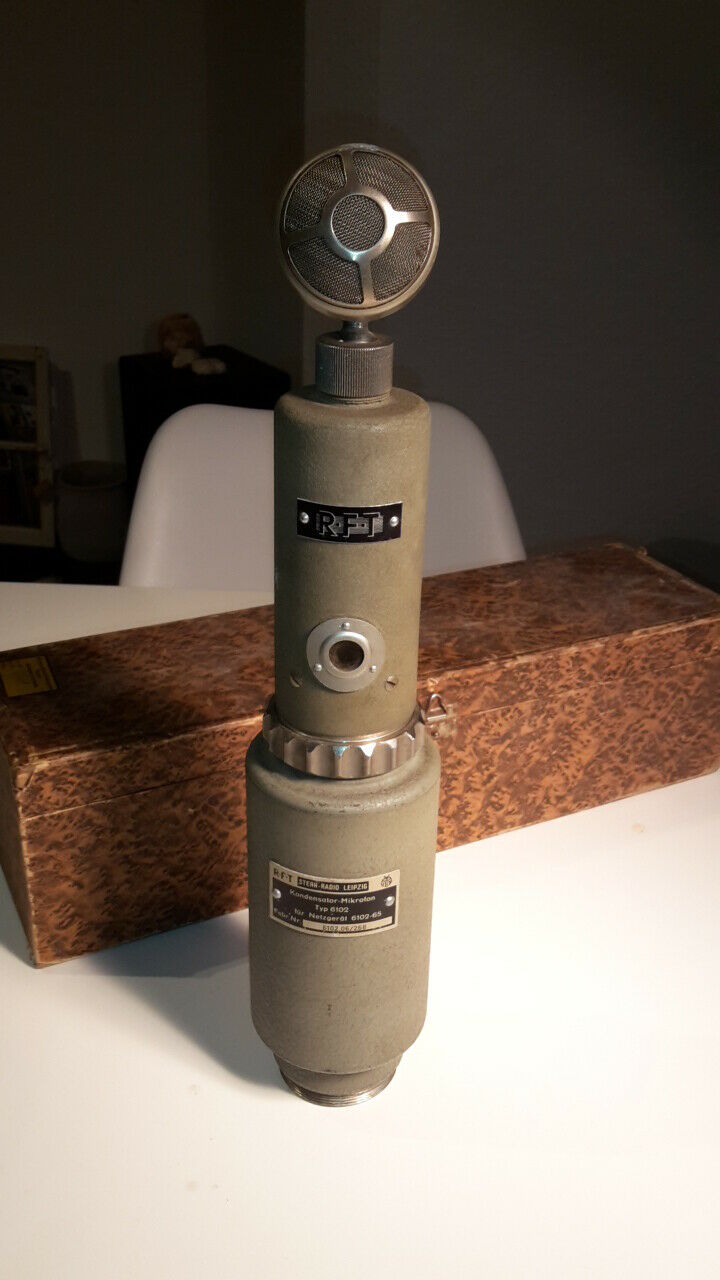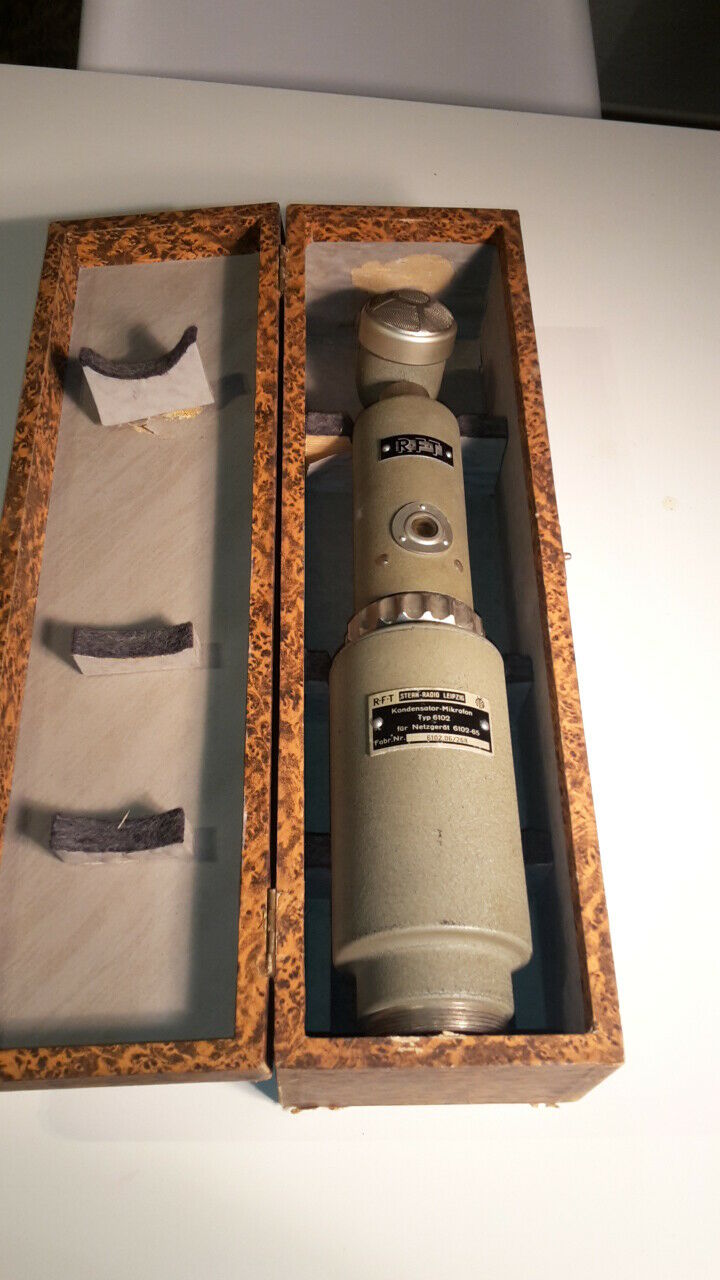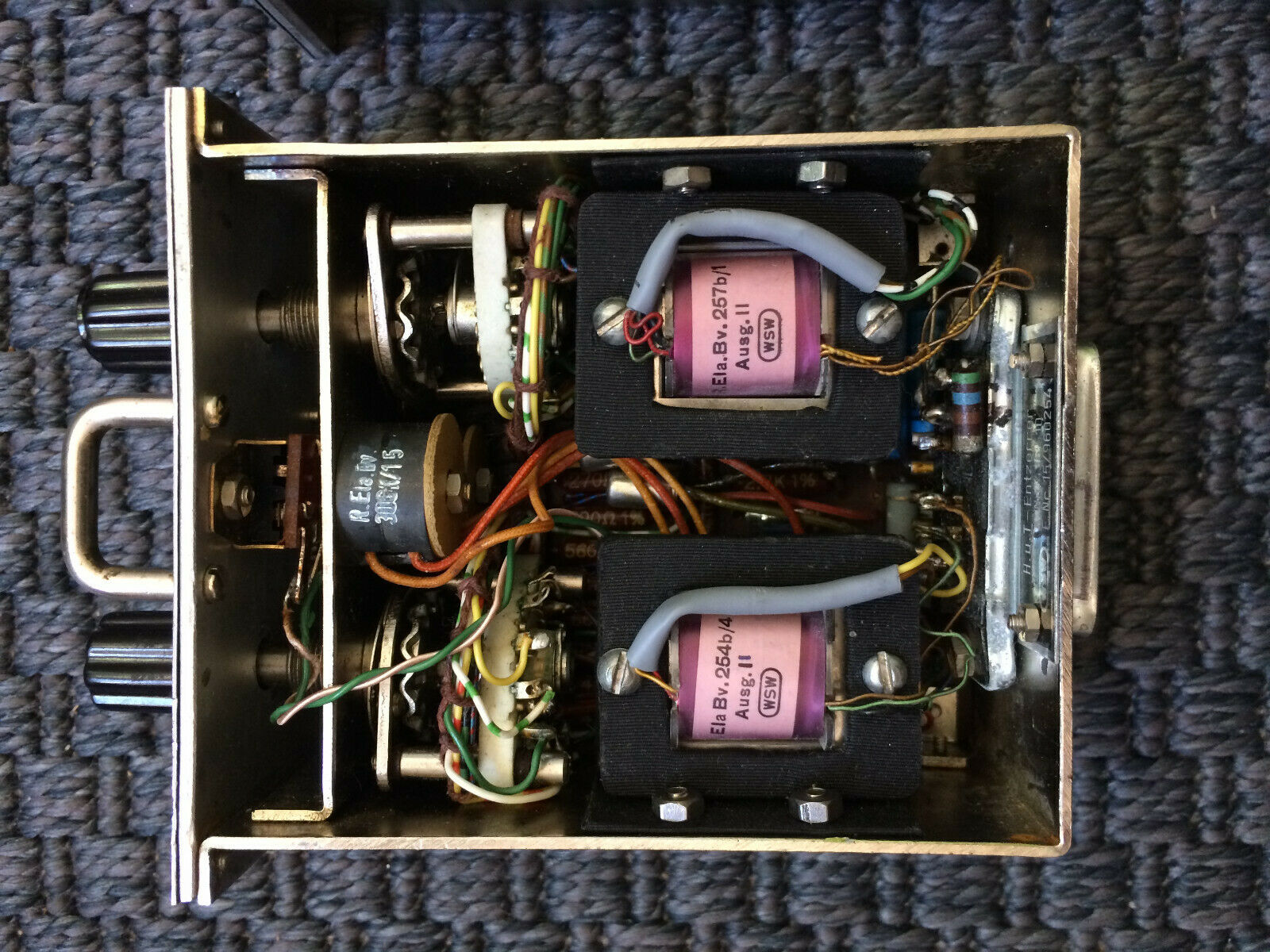
Siemens WSW, RFT, RFZ STUFF
°°°*°°°

RFT Typ 6102

°°°°°°°°°°°°°°°°°°°°°°°°°°°°°°°°°°°°°°
The N324 is a highly sought Vintage power supply 24 V and is a PRICE 1989 = 1880 DM - Support:
Siemens U273 V272 V274 V275 V276 W295 W295a W295b
TAB U373a V372 V372D V372DS V374 V376 W395
Neumann U473 V472 V457 V475 V476 W295 W491 W492 W495
Telefunken V672 V673 V674 V675 V676a V676b V676c W695
Lawo V972 U973 V976 W995
and units from NTP RTW EMT Maihak ...
The N324 can supply up to 40 units.
°°°°°°°°°°°°°°°°°°°°°°°°°°°°°°°°°°°°°°°°°°°°°°°°°°°°°°
SIEMENS WSW
WSW 601431 -A or B or C


WSW 601 432c Limiter



WSW 601 433
A germanium begrenzer
B Germanium Kompressor begrenzer
C silizium Kompressor Begrenzer

WSW 436511 Equalizer



WSW 436512 Equalizer

WSW 436 523 B

WSW 811301 Tube UA preamp
WSW 811402 Germanium UA preamp
WSW 811403 Silicon UA preamp - WSW UA 811403, MIC-PREAMP, 70dB GAIN, MADE IN AUSTRIA 1968


WSW 811450B Germanium Line Preamp
WSW 811453 Silicon Line Preamp


WSW 601430S, GERMANIUM LIMITER, 1958 AUSTRIA



WSW EQ LOW-HI

WSW (Wiener Schwachstrom Werke-> Vienna Lowcurrent Plant) was the Austrian branch of Siemens audio division and made similar looking versions of the Siemens and Klangfim gear that was mostly identical in electronic design and circuit. There are some WSW version of the V72 as well as the Movie EQs. During the late 60 early 70s WSW build am entire line of audio equipment that was mostly for the Austrian broadcast market as well for export to former Austrian territory (like Hungary, etc) 24 Volt.
Those units are very high quality but sometimes hard to find replacement parts for or even a schematic. After Siemens closed their "Wernerwerk" were all V/U and Klangfilm modules were made they shifted the production to Vienna and made the last Sitral consoles there up to 1988 or so, the factory stopped making audio equipment in 1990.
How to deal/how to buy today? As long a proper set of schematics are supplied there should be no problem to buy them, but as I said, the replacement part situation is quite difficult, especially the "Duennfilm" chips that were used as active part....
I know few generations of WSW Preamps
late 50s .........
Tube ones marked as 811350 LINE AMPS (also called IA - isolation amp).. kinda WSW v72  (as far as i know v72 was also buffer in design ).. 34 db of gain amplification... another one is 811301 ... tube HI gain amp .. not marked as UA (universal amp) but grand daddy of latter UA preamps. UA are differential amps!!!
(as far as i know v72 was also buffer in design ).. 34 db of gain amplification... another one is 811301 ... tube HI gain amp .. not marked as UA (universal amp) but grand daddy of latter UA preamps. UA are differential amps!!!
811301 had over 70 db of amplification and 2 different impedance inputs on input transformer!!! .. I recommend using Eckmiller or EAB fader after that ones couse they are really HOT and LOUD!!!!
Sound is awesome ... no artifacts , no hum , no noise, clean and very rich with details!!!
--------------------
early 60s
WSW introduced germanium modules ....
early ones were 811401 UA and they added 3 different impedance inputs on input transformer... from all WSW amps only Germanium ones had interstage transformer in design .... also that generation had first generation of IA called 811450...
latter mid 60s WSW germanium upgraded their modules to 811402 UA and 811450B and 811451!!
I had small 6 channel wsw germanium console with great sounding preamps ..BUT i cant remember number of model!!!!
..............................
late 60s
WSW introduced their silicon compact console !!!! to me one of best sounding pres are in that console.... module called 811510B
that is mid 60s design of gain amp i found same in latter NEVE 1073 .. BA183 and BA184 modules from 1972
WSW 811510B had that preamp design in 1966!!!!!!!!!!
also in set and tradition of UA and IA amps WSW made silicon version of UA called 811403.... and IA called 811453!!!
just for reference they made few revisions of 811453 and also created 811454 diferential IA with cca 34 db of amplification!!!
they had that design till 80s!!!!!!
/////////////////////////////////////////
they are 99% full range. Only one i ever had was Line amp 811453C that has 100hz hi pass
811510B very good for everything ... great on vocals, synths, Drums.....o yes BASS
The Universal Amplifiers - well, as the name suggests - are designed to be utilized as high-gain microphone preamps, as well as program/mixing amplifiers, etc. depending on the input (different taps on the input transfomers) and gain (~30-70 dB) used...
There are usually many versions and sub-versions (e.g. there was a version of 811 301 w/6072A tubes at the input). The 811 301 was a 1960s design and as such, it is a pinnacle of tube technology - low noise, no distortion, very clean sound w/extended freq. response. As mentioned earlier, not that much of a "tube sound". The Germanium modules followed shortly in 1965. The Compact Module System program was later modernized w/ discreet silicon transistor technology (the 811 403 are excellent!), and later w/ IC designs (e.g. there was an IC-based limiter module called "LIM").
°°°°°°°°°°°°°°°°°°°°°°°°°°°°°°°°°°°°°°°°°°°°°°°°°°°°°°°°°
Siemens U 273 Comp
In 1960, Siemens introduced the U273 the world’s first solid state compressor. There is a dispute over whether or not Neve based their 2254 compressor on this module. There are striking similarities to the schematics but one of the main differences is that the Neve uses Marinair transformers while the U273 used Haufe. The Siemens U273 is one of the best sounding transistor compressors ever made.
Siemens 295 EQ
the W295 has two of those slides on the front for presence (freq and amount)

the W295a is a brandaxall design and doesn't have the freq shift knob
the W295b has the freq shift knob on the presence (mids)
Höhen: 10 kHz, +/- 15 dB Tiefen: 60 Hz, +/- 15 dB Präsenz / Absenz: 0,7 / 1,0 / 1,5 / 2,3 / 3,5 / 5,6 kHz, +/- 8 dB 24 volt

![]()
the W295d has that too but slightly different layout
RFT - RFZ

RFT V 781 Stereo


RFZ was the central technological development, research, and production center for broadcast radio and television in former East Germany, and made some pretty fine and unique sounding gear as well. Incidentally, they also made wire-tapping and eavesdropping devices used by the Stasi (Staat Sicherheit - State Security or the East German quasi-version of the CIA) to spy on just about everybody remotely suspicious in the former German Democratic Republic. Most of their designs were based on Telefunken ELA-Technik designs, or were under the supervision or consultation of ELA-Technik engineering designers, the same engineers who designed so many classic Telefunken preamps, EQ's, and compressors.
So how do they sound, you ask? They're nice and solid sounding on the low-end without being dark or muddy and nicely smooth throughout the rest of frequency spectrum with a slight bit of an aggressive presence. Plenty of gain is available for even the lowest of low-output ribbon mics and you can use the line inputs to run your samplers and keyboards through to warm them up a good bit. These come highly recommended on drums and guitars, but work quite well as an all-around preamp.
From the fine Volks at RFT (Radio Fernseh Technik - "Radio Television Technology/Engineering), the former East German broadcast technology conglomerate who had their collective hands in almost all things dealing with professional and consumer electronics in the German Democratic Republic (East Germany), come the early-70's MV810/2 microphone preamps. These things are extremely rare and along with one other model of preamps that will remain unmentioned, were the flagship preamps for high-end recording in the GDR. Their design was likely overseen by representatives of Telefunken's ELA Technik design and research division in the Hannover area in the mid 70's, many of the same designers responsible for the majority of the classic Telefunken modules (ELA Technik moved from Hannover to Wolfenbüttel in 1974), and likely built by RFZ (Rundfunk und Fernsehtechnisches Zentralamt - directly translated "Broadcast and Television Technical Central Bureau) located in East Berlin, to be released under the conglomerate label RFT.
These things are extremely rare and along with one other model of preamps that will remain unmentioned, were the flagship preamps for high-end recording in the GDR. Their design was likely overseen by representatives of Telefunken's ELA Technik design and research division in the Hannover area in the mid 70's, many of the same designers responsible for the majority of the classic Telefunken modules (ELA Technik moved from Hannover to Wolfenbüttel in 1974), and likely built by RFZ (Rundfunk und Fernsehtechnisches Zentralamt - directly translated "Broadcast and Television Technical Central Bureau) located in East Berlin, to be released under the conglomerate label RFT.
The build quality is absolutely superb and once all necessary capacitors are changed these things are just plain mean- a regular Bad-Mama-Jama of a rock 'n roll mic preamp. Tone monsters they are- big and thick on the low end, rich and warm throughout, yet soft and silky on the top. They are excellent on bass, drums, electric guitars and anything you want to thicken, tighten, and warm-up a bit. These are a great pairing with their RFT V742C line amp .
The KV80 line/microphone-preamps have been developed by the R F Z ( Central Bureau of Radio and Television,
Berlin) in east germany. This was a broadcast ( research ) authority of the GDR. The developments were concentrated and one of the highest priority in the GDR.
More than enough money, time and highly skilled engineers and technician were available. Patent law was not an issue. The RFZ developed most things by themselves, but also were interested in western-german developements. Adopted them and sometimes even improved them by an even more clever and to the point approach. Due to the production of LP's (AMIGA= Pop etc., ETERNA=Classical) which was a renommé object of the GDR, the highest claim was to reproduce music as truthful and natural sounding as possible. It was not enough to do all the measurements while developing for example a preamp. They even had a listening group which consisted of people, with skilled ears, trained by constant visits of classical concerts.
The RFZ is famous for their amazing quality mixing desks of the 700-series (V781, V741, V740). Those preamps are known as absolutely fantastic sounding but they are very rare. Not much of them were made as they have been produced for professional purposes only and were very expensive (the price for a pair of two KV80 preamps was higher than the average monthly income of a GDR citizen from the workin-class at that time). With the 800-series (KV800, KV80, FB80 etc.) the RFZ fullfilled the need for more compact format consoles while maintaining the audiophile qualities or even exceed them.
Attention: supply voltage -20...-24V
A completely soldered cable with all necessary connectors (XLR in and out) is provided as well as two additional 8pin connectors for the second preamp.
I made this cable to test the preamps, this cable is not intended for regular use! And most important: the preamps need -20...-24V with reference to ground.
A "standard German broadcast Power Supply" usually has +24V with reference to ground and its "0V" connection is also tied to ground. So if you use such
a power supply, the V742 will have +24V on the chassis and over the shield of the cables you will have +24V on PIN1 of the XLR sonnectors!
If you then connect it to another piece of gear (which has ground connection) you will cause a short circuit in your 24V power supply! So,
use a proper power supply and make sure you understand what you do BEFORE connecting the preamps! I will not take any responsible for any damage caused
if anyone uses this cable!
RFT / RFZ V742d Preamp Full Discrete (Can be mod)
The 742 can be modifyed to a max. gain of 65 dB, instead of max gain of +40 dB.
Modding the ratio of input transformer like the model 810 (Use the same trafo), from ratio 3:1 of 742 to ratio 1:3 of the 810.!!!!!





The MV 810 and the MV 810/2 are developed at Funkwerk Kölleda. This company wasn´t a part of the RFZ (Rundfunk- und Fernsehtechnischen Zentralamt der Deutschen Post). This preamps are a part of the System L800 for electroacoustical installation in different locations. For instance: clubs, bars and so on. The MV 810 uses for all stages germanium-transisitors. At the end they use an single ended class-a amplifier. Because the former germanium transistors haven´t an high transit-frequency they use an parallel-resonace-inductor to get enough frequency response. The MV 810/2 was the last development in this Sytem L800 with the same pinout. This unit was an complete new construction in the electronical part. They use the same rotary switcher, housing an so on. The W 734 wasn´t only developed and not only built for the Ministerium für Staatssicherheit (called STASI). It was an part of the modul system V 700. It´s an great eq i think. The V781 was developed in the 70´s. There are two discrete operational amplifiers inside. The output has very low resistance and it is unbalanced. The transformers for balancing will be located in the mainframe. The primary V781 will be fully built discrete. That V781ay in your picture was one of the last. Here is an IC (i think B08x) in the output stage in use. ay says that there are special quality contacts in use (i think Gold). Reference for all units is +24Volts (V 700 series) or +20Volts (MV 810 and MV 810/2). So you must use different power supplys for west- and east german modules. For best noise rejection connect shield on Pin 1 at the sender. At www.jensen-transformers.com are very good information about Pin 1
problem. |
|---|
VEB Funkwerk MV 4056
RFT 713 Limiter

Thursday 19-sep-19 8:53 PM
